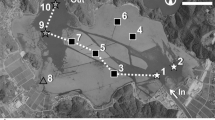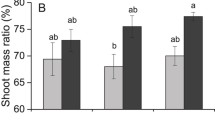Abstract
Vegetated areas of rivers and estuaries are capable of affecting the concentration of dissolved and particulate matter in water masses traversing those plant beds. We examined whether different sizes of water chestnut (Trapa natans) beds in the Hudson River, USA, alter dissolved oxygen, nutrients and turbidity of water masses. Ebb–tide water was sampled from four water chestnut beds in the tidal freshwater portion of the Hudson River estuary and each site was sampled multiple times during the growing season and once following plant senescence. Water quality variables included dissolved oxygen, turbidity, dissolved organic carbon, and inorganic nutrients. Samples from the small beds (575 m2 and 624 m2) were compared with large beds (16 600 m2 and 24 820 m2). Dissolved oxygen of water flooding vegetated beds in the hour before high tide was 7.18±1.03 mg/l (mean±standard deviation) with a range of 5.5–9.8 mg/l throughout the growing season. Water samples collected as water ebbed from the plant beds showed that only the large beds had an effect on dissolved oxygen with the largest declines in oxygen exhibited by the largest bed. Decline of dissolved oxygen in the water ebbing from the largest bed averaged 1.5±0.4 mg/l/h with a minimum of 4.5 mg/l, equivalent to 54% of saturation, a level at which sensitive fauna are negatively affected. There were no significant relationships between bed size or plant presence and inorganic nutrients, turbidity or DOC. Ebb–tide nitrate was never lower than 87% of flood tide means. Effective management of invasive plants must consider both the variability in effects among plant beds and the areal coverage of plant bed sizes.
Similar content being viewed by others
References
M. A. Abdelrhman (2003) ArticleTitleEffects of eelgrass Zostera marina canopies on flow and transport Marine Ecology Progress Series 248 67–83
InstitutionalAuthorNameALPKEM (1991) ALPKEM Corporation Clackamas Oregon
N. F. Caraco J. J. Cole (2002) ArticleTitleContrasting impacts of a native and alien macrophyte on dissolved oxygen in a large river Ecological Applications 12 1496–1509
N. F. Caraco J. J. Cole S. E. G. Findlay D. T. Fischer G. G. Lampman M. L. Pace D. L. Strayer (2000) ArticleTitleDissolved oxygen declines in the Hudson River associated with the invasion of the zebra mussel (Dreissena polymorpha) Environmental Science and Technology 34 1204–1210 Occurrence Handle10.1021/es990565z Occurrence Handle1:CAS:528:DC%2BD3cXht1yjsLw%3D
J. F. Clark H. J. Simpson R. F. Bopp B. Deck (1992) ArticleTitleGeochemistry and loading history of phosphate and silicate in the Hudson estuary Estuarine, Coastal and Shelf Science 34 213–233 Occurrence Handle1:CAS:528:DyaK38Xit1Wisrw%3D
Coote, T. W., R. E. Schmidt & N. Caraco, 2001. Use of a periodically anoxic Trapa natans bed by fishes in the Hudson River. In Waldman, J. R. & W. C. Nieder (eds), Final Reports of the Tibor T. Polgar Fellowship Program, 2000. Hudson River Foundation, New York, Section IV, pp. 1–20.
G. E. Crow C. B. Hellquist (2000) Aquatic and Wetland Plants of Northeastern North America. Volume 1 of 2 The University of Wisconsin Press Madison, Wisconsin
G. E. Davenport (1879) ArticleTitleTrapa natans Bulletin of the Torrey Botanical Club 6 352
S. Findlay K. Schoeberl B. Wagner (1989) ArticleTitleAbundance, composition and dynamics of the invertebrate fauna of a tidal freshwater wetland Journal of the North American Benthological Society 8 140–148
S. Findlay R. Sinsabaugh D. Fischer P. Franchini (1998) ArticleTitleSources of dissolved organic carbon supporting planktonic bacterial production in the tidal freshwater Hudson River Ecosystems 1 227–239 Occurrence Handle10.1007/s100219900018 Occurrence Handle1:CAS:528:DC%2BD3cXptFeiuw%3D%3D
S. Findlay M. Pace D. Lints (1991) ArticleTitleVariability and transport of suspended sediment, particulate and dissolved organic carbon in the tidal freshwater Hudson River Biogeochemistry 12 149–169 Occurrence Handle10.1007/BF00002605 Occurrence Handle1:CAS:528:DyaK3MXmtFChs7g%3D
J. D. Frodge G. L. Thamas G. B. Pauley (1990) ArticleTitleEffects of canopy formation by floating and submergent aquatic macrophytes on the water quality of two shallow Pacific Northwest lakes Aquatic Botany 38 231–248 Occurrence Handle10.1016/0304-3770(90)90008-9
George, J. R. & K. T. Alben, 1999. Characteristics of dissolved organic carbon from Trapa natans wetlands and the Hudson River. In Nieder W. C. & J. R. Waldman (eds), Final reports of the Tibor T. Polgar Fellowship Program, 1998. Hudson River Foundation, New York, New York, Section III, pp. 50–107.
W. R. Gilchrest (1998) A comparison of fish communities in an open and an occluded freshwater tidal wetland in the Hudson River estuary Bard College, Annandale-on-Hudson New York 29
H. A. Gleason A. Cronquist (1991) Manual of Vascular Plants of the Northeastern United States and Adjacent Canada EditionNumber2 New York Botanical Garden Bronx, New York 910
Goldhammer A. & S. E. G. Findlay, 1988. Estimations of suspended material flux between a Trapa natans stand and the Hudson River Estuary. In Waldman J. R. & E. A. Blair (eds), Final Reports of the Tibor T. Polgar Fellowship Program, 1987. Hudson River Foundation, New York, New York, Section VIII, pp. 1–46.
A. T. Groth L. Lovett-Doust J. Lovett-Doust (1996) ArticleTitlePopulation density and module demography in Trapa natans (Trapaceae), an annual, clonal aquatic macrophyte American Journal of Botany 83 1406–1415
S. Hamashima (1983) ArticleTitleCorrelation of the flora of aquatic macrophytes with the chemical contents of water in the irrigation reservoirs of Tokai district Japanese Journal of Limnology 44 1–5
J. Juget J. C. Rostan (1973) ArticleTitleThe effect of the macrophyte Trapa natans on the dynamics of a pond during the summer period Annals of Limnology 9 11–23
Y. Kadono (1982) ArticleTitleOccurrence of aquatic macrophytes in relation to pH, Ca++, Cl− and conductivity Japanese Journal of Ecology 32 39–44 Occurrence Handle1:CAS:528:DyaL38XksFals7Y%3D
V. Kaspati P. Pomogyi (1979) ArticleTitleAccumulation and release of nutrients by aquatic macrophytes Symposium of Biology in Hungary 19 33–42
E. Kiviat (1987) Water chestnut (Trapa natans) D. J. Decker J. W. Enck (Eds) Exotic Plants with Identified Detrimental Impacts on Wildlife Habitats in New York State Cornell University New York 31–38
E. Kiviat (1993) ArticleTitleUnder the spreading water chestnut News From Hudsonia 9 1–6
G. G. Lampman N. F. Caraco J. J. Cole (1999) ArticleTitleSpatial and temporal patterns of nutrient concentration and export in the tidal Hudson River Estuaries 22 285–296 Occurrence Handle1:CAS:528:DyaK1MXmsVOmtrk%3D
K. E. Limburg M. A. Moran W. H. McDowell (1986) The Hudson River Ecosystem Springer-Verlag New York 329
W. C. Muenscher (1944) Aquatic Plants of the United States Cornell University Press Ithaca, New York 374
H. Nakano H. Seki (1981) ArticleTitleImpact of nutrient enrichment in a water chestnut ecosystem at Takahama-Iri Bay of Lake Kasumigaura Water, Air, and Soil Pollution 15 215–227 Occurrence Handle10.1007/BF00161254
W. C. Nieder E. Barnaba S. E. G. Findlay S. Hoskins N. Holochuck E. A. Blair (2004) ArticleTitleDistribution and abundance of submerged aquatic vegetation and Trapa natans in the Hudson River Estuary Journal of Coastal Research 45 150–161
Pelczarski, K. & R. E. Schmidt, 1999. Evaluation of a pop net for sampling fishes from water chestnut beds in the tidal Hudson River. In Blair E. A. & J. R. Waldman (eds), Final Reports of the Tibor T. Polgar Fellowship Program, 1990. Hudson River Foundation, New York, Section V, pp. 1–33.
S. S. Sastroutomo (1982) ArticleTitleSummer biomass of aquatic macrophytes in relation to sediment characteristics in Lake Aino-Nume, Miyaga Japanese Journal of Ecology 32 45–55
Schmidt R. E. & E. Kiviat, 1988. Communities of larval and juvenile fish associated with water chestnut, watermilfoil and water-celery in the Tivoli Bays of the Hudson River (Report to the Hudson River Foundation, New York).
R. E. Schmidt A. B. Anderson K. Limburg (1989) Dynamics of larval fish populations in a Hudson River tidal marsh C. L. Smith (Eds) Estuarine Research in the 1980s State University of New York Press Albany, New York 458–475
Simpson, H. J., D. E. Hammond, B. L. Deck & S. C. Williams, 1975. Nutrient budgets in the Hudson River estuary. In T. M. Church (ed.), Marine Chemistry in the Coastal Environment. American Chemical Society Series No. 18, pp. 619–635.
D. L. Strayer C. Lutz H. M. Malcom K. Munger W. Shaw (2003) ArticleTitleInvertebrate communities associated with a native (Vallisneria americana) and an alien (Trapa natans) macrophyte in a large river Freshwater Biology 48 1938–1949 Occurrence Handle10.1046/j.1365-2427.2003.01142.x
N. Takamura Y. Kadono M. Fukushima M. Nakagawa B-H. O. Kim (2003) ArticleTitleEffects of aquatic macrophytes on water quality and phytoplankton communities in shallow lakes Ecological Research 18 381–395 Occurrence Handle10.1046/j.1440-1703.2003.00563.x Occurrence Handle1:CAS:528:DC%2BD3sXnsVSnurk%3D
T. Tsuchiya T. Iwakuma (1993) ArticleTitleGrowth and leaf life-span of a floating leaved plant, Trapa natans L., as influenced by nitrogen influx Aquatic Botany 46 317–324 Occurrence Handle10.1016/0304-3770(93)90011-K Occurrence Handle1:CAS:528:DyaK2cXisVensbw%3D
R. G. Wetzel (1969) ArticleTitleFactors influencing photosynthesis and excretion of dissolved organic matter by aquatic macrophytes in hard-water lakes International Vereinigung für Theoretische und Angewandte Limnologie 17 72–85
R. G. Wetzel (2001) Limnology: Lake and River Ecosystems EditionNumber3 Academic Press San Diego, CA
Author information
Authors and Affiliations
Corresponding author
Rights and permissions
About this article
Cite this article
Hummel, M., Findlay, S. Effects of Water Chestnut (Trapa natans) Beds on Water Chemistry in the Tidal Freshwater Hudson River. Hydrobiologia 559, 169–181 (2006). https://doi.org/10.1007/s10750-005-9201-0
Received:
Revised:
Accepted:
Issue Date:
DOI: https://doi.org/10.1007/s10750-005-9201-0




